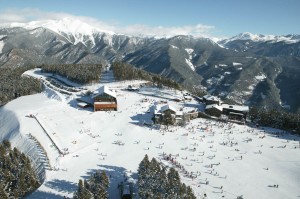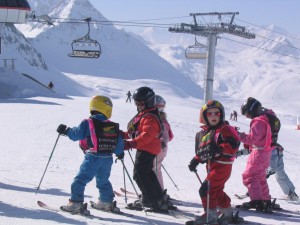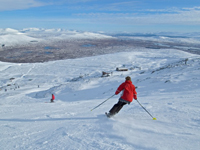Ski in Europe – an overview
Europe has long been a family favourite for ski holidays thanks to the winning formula of cheap flights, short travel times from the UK, and child-friendly resorts to suit all tastes and budgets.
This overview provides a very general overview – it goes without saying there are exceptions to every rule!
ANDORRA
For years, Andorra had a reputation for lively singles and couples holidays, fueled by duty-free alcohol. In recent years, however, a considerable amount of investment in new hotels, lifts and snow-making facilities has transformed it into a more upmarket, family-friendly destination. In October 2011, Andorra was declared the cheapest ski destination in the Eurozone in the Post Office Ski Resorts Report. You can read more about Andorra and holiday pricing in FamilySkiNews’ Step Forward Andorra news report.
There are two main ski regions: Grandvalira is served by the resorts of Soldeu and Pas de la Casa; and Vallnord comprises Arinsal and Pal. Both regions are popular with British families, with excellent English-speaking ski schools.
The area is not particularly easy to access. The nearest airports are Toulouse or Perpignan in France; and Barcelona in Spain.
AUSTRIA
The resorts of Austria are easily accessed by plane to Innsbruck, Salzburg, Vienna, Klagenfurt and even Zurich, just a short train ride across the Swiss border from the Vorarlberg.
Many of the resorts in Austria are bustling historic towns or chocolate-box ski villages, unlike some of their foreign purpose-made (and often ugly) counterparts, and they therefore often ooze charm and traditional atmosphere. The drawback though is that there is little ski-in-ski-out accommodation, so expect a walk or bus-ride to the lifts. Prices are modest compared with France and Switzerland, but many resorts are at low altitudes, which can be a problem in mild weather or in seasons with limited snowfall.
Some of the quieter resorts of the Tirol are especially suited to families, including Serfaus, Kirchberg and Obergurgl. Extensive ski areas, such as SkiWelt (embracing the resorts of Ellmau and Scheffau) and Saalbach-Hinterglemm are also ideal destinations for those with young families, while teenagers gravitate towards trendier resorts of St Anton and Ischgl, with their famed nightlife and strong boarding vibes.
Many Austrian hotels have devoted kids’ programmes and there is even a chain of luxury childrens’ hotels – see our report on KinderHotels – with luxury facilities pampering parents as well as their offspring. Several even have their own private ski-schools.
BULGARIA
Bulgaria is very much on the ski-radar nowadays, although prices are not a cheap as they once were. Nonetheless, Bulgaria remains an excellent value choice for young families and for those on a tight budget, but they don’t suit keen intermediates eager to clock up ski-mileage.
In recent years, accommodation and lift facilities have improved and the English-speaking ski schools have an excellent reputation. Ski areas are limited but ideal for beginners, with the exception of Borovets, where there is little to cut your teeth on between the crowded nursery slopes and some long, steep red runs. Pamporovo is a better bet with plenty of short, easy runs; or atmospheric Bansko, with a lovely snow garden, a Kindergarten (age 4-7yrs) and runs to suit all levels. The characterful town, traditional cuisine and local culture ensure a very different holiday experience to the Alps.
FRANCE
The French Alps boast some of the largest, highest, most snow-sure ski regions in Europe, including the vast Trois Vallees (including Courcheval, Méribel and Val Thorens) and Paradiski (centred on the ski areas of La Plagne and Les Arcs). There are over 400 ski resorts in France. The big-name resorts are never going to be cheap but they do offer excellent and varied family amenities. The famed resorts of Val d’Isère and Tignes, for instance, are popular family choices – versatile enough to cater for young beginners through to the most advanced skiers. When planning a vacation in France, look out for resorts bearing the Famille Plus Montagne label to find some of the nation’s most family-friendly resorts.
Many French resorts are modern and purpose-built, providing plenty of self-catering apartments and slope-side accommodation. Where some may lack architectural charm, they more than compensate in family convenience, with skiing, shops and ski-schools all on the doorstep.
The abundance of self-catering options keeps ski-package prices relatively affordable in France. Fully-catered chalets are pricier but also popular – especially in the more village-style resorts such as Oz en Oisans and Montchavin, where self-catering options are limited. Fully-catered chalets provide all meals (including afternoon tea and cakes) in a cosy family setting.
The ski season is long in France – typically from early December to mid-April, with year-round glacier skiing in some resorts. The French Alps are also relatively easy to access, by plane to Grenoble, Chambery, Nice and Geneva; by fast TGV trains from London and Paris(including the Snowtrain); or by car from mainland Europe and the UK. You can see our feature on driving to the Alps here.
The French Pyrenees also have a few small resorts which have recently grown in popularity, thanks to the introduction of budget airlines flying into Pau and Perpignan. The largest area in the Pyrenees is the Domaine du Tourmalet, with around 100km of pistes. The other ski zones here tend to be small and family-oriented, with traditional-style hotels appealing primarily to the French and to Brits with a hire car and a desire for la vrai France.
FINLAND
If you’re happy to forego the glitz and glamour of the Alpine resorts, the low-key resorts of Finland are an excellent choice. Be forewarned though – it can be perishingly cold; there is little daylight; and ski areas are small and unsuitable for those looking to clock up the kilometers on skis. But there is plenty of small-scale beginner and intermediate skiing, in such resorts as Levi and Ylläs. Snowboarding is big here, with some great terrain parks to keep teenagers amused. Finland also offers reliable snow and a long snow-sure season.
Some resorts (including Ruka, Yllas, Levi and Iso-Syote) open a small number of runs as early as November. In midwinter, the resorts operate only the floodlit pistes (as the sun doesn’t rise). Peak season is from mid-February onwards, when resorts are fully open and there is usually good late season snow too.
The ski schools have an excellent reputation, with English-speaking instructors, and most ski areas have an indoor playroom for small children. Non-skiers can enjoy toboganning, ice-fishing, husky-mushing, reindeer-pulled sleigh rides, snowmobile safaris and countless saunas. You may also wish to combine your ski trip with a visit to see Santa?
Finland is easier to access than you might think: Fly to Kittilä airport for easy access to Levi and Ylläs; to Kuusamo airport for the smaller resorts of Ruka, Pyhä and Iso-Syöte.
ITALY
Northern Italy has had some of the best quality snow in recent years, and plenty of great family resorts, including Cervinia, Livigno, La Thuile, Sauze d’Oulx, and Sestriere – part of the 400km Via Lattea (Milky Way) circuit.
Italy also boasts modest prices compared with its pricier neighbours – Austria, Switzerland and France. Many resorts have powerful, state-of-the-art lift systems, top-notch piste grooming, and huge snowmaking facilities. The Italians have a world-wide reputation for their love of children. Most resorts are therefore very welcoming to families, with excellent childcare facilities and good ski schools for the little ones too.
The resorts span the north Italian border from France across to the Dolomites and many resorts link into the neighbouring countries (including La Thuile with La Rosière in France; and Cervinia with Zermatt in Switzerland). The Dolomiti Superski area straddles the provinces of Veneto, Trentino and Alto Adige/Südtirol, and is broken down into 12 areas, each embracing a number of resorts. In total, the Superski area covers 45 resorts, 1,200km of pistes and over 450 lifts. It includes such popular destinations as Val Gardena; and fashionable Cortina d’Ampezzo, and Madonna di Campiglio, where the pistes are especially crowded with local weekend skiers but quieter during the week.
Italian ski resorts, as a general rule, are not very easily accessible. There are three main geographical groupings of resorts – each quite far apart. Fly into Turin for Sauze d’Oulx, Sestriere and other resorts of the Milky Way (Vialattea) region. Fly to Turin or Geneva for the resorts of the Aosta valley (including Courmayeur, Cervinia, La Thuile and the Monterosa area), or you may find a good price flight to Milan. The Aosta valley can also be accessed by car from Switzerland via the Grand St Bernard tunnel. Courmayeur is the easiest resort to reach by car from Britain, via the Mont Blanc Tunnel from Chamonix in France. Further east, the resorts of the Dolomites are best accessed from Innsbruck(Austria), Verona or even Venice. Otherwise it is a lengthy transfer from Milan.
NORWAY
Norway is one of the best places in Europe for cross-country skiing, and it is the home of telemark skiing. However, few Nordic ski areas and short daylight hours make this a limited destination for families wishing to develop their downhill skiing skills.
Lillehammer is the oldest and best-known resort, put on the skiing map by the Winter Olympic Games in 1994, and near the top cross-country areas of Nordseter and Sjusjøen.
Hemsedal, another top resort, is known as the Scandinavian Alps, with runs up to 1,920m and a season stretching from November to May. One of the country’s largest ski areas, with dedicated areas for children and beginners, and snowboard parks, it appeals to children of all ages and abilities. Other popular Norwegian resorts include Geilo, Kvitfjell and Trysil.
SCOTLAND
Skiing in Scotland is great if you’re Scottish (or can access the slopes with ease). However, snowfall here is just too unpredictable to replace your annual ski-trip to the Alps with one to the Scottish Highlands. When there is snow, the resorts are ideal for beginners and intermediates. The best-known resort is Cairngorm, centred on Aviemore; the highest is the Nevis Range; and the largest is Glenshee. Scottish skiing is good value, with good, affordable accommodation.
SLOVENIA
The ski resorts of Slovenia, situated in the Julian Alps, may lack the dramatic Alpine scenery of the 3,000-metre peaks of Switzerland, France and Austria, but it is an ideal destination for novice skiers and families, with plenty of beginner and intermediate runs. With competitively-priced ski lessons and ski passes; devoted children’s ski areas; and low-priced food and drink, it is considerably more affordable than its more celebrated ski neighbours. It is also a popular cross-country skiing destination.
The main resort is Kranjska Gora – host of the Alpine Skiing World Championships, lying close to the Italian and Austrian borders at an altitude of 1,100m. Best-known for hosting the Alpine Skiing World Championships, it is especially popular with local families at weekends, with 30km of wide, gentle runs. Accommodation ranges from traditional independent alpine hotels to cheaper budget chains. Slovenia’s largest ski area is Maribor-Pohorje, with excellent snowmaking facilities and floodlit night skiing. Both areas are covered by the same lift pass.
All of the Slovenian ski resorts are easily accessible by bus or taxi from the capital city, Ljubljana.
SPAIN
It’s hard to generalize about Spain, except to say that the colourful Spanish culture provides a totally different holiday experience from the Alps and, with lower prices for food and drink, ski holidays here are often more affordable too. As in Italy, Spaniards are known for their hospitable welcome towards children, although as a general rule of thumb, childcare in resort is more limited than in the larger resorts of theAlps.
Most Spanish resorts are located in the Pyrenees. The largest resort is Formigal, with 137km of pistes, many of which are easy, gentle runs; and a snow garden (for kids aged 4 months -2 ½ years). There’s even toboganning, dog-sledding and snowmobiling for non-skiers; and terrain parks and boarder-cross to entertain boarders. The luxury Pyrenean resort of Baqueira-Beret – the winter playground of the Spanish royals – appeals to beginners and intermediates, with 120km of pistes, a snow park (for kids aged 3 months-2 ½ years) and three dedicated nursery areas for children. Be prepared for lengthy transfer times to Pyrenean resorts though – from Bilbao, Barcelona or Girona airports.
In southern Spain, there’s surprisingly high altitude skiing in the Sierra Nevada, a modern resort with a reasonably reliable snow record and excellent nursery slopes. It’s situated near the city of Granada – a popular city break destination – and is busy with local skiers at weekends.
SWEDEN
As with all Scandinavian countries, Sweden not only offers excellent skiing, but also an entirely different atmosphere and culture from the Alps. Accommodation standards are very high, resorts are snow-sure from December to May, and the slopes are uncrowded by Alpine standards. However, with high living costs, it can be an expensive holiday option.
As well as downhill, cross-country skiing and snow-shoeing are especially popular. For non-skiers, there are plenty of other activities including husky mushing, ice fishing, snowmobile safaris and reindeer trekking. Sweden’s main (and largest) resort is Ǻre, with plenty of terrain for beginners and intermediates. The ski school has an excellent reputation and there are several devoted childrens’ ski areas. Lift passes are free for all kids under seven, as long as they wear a helmet.
SWITZERLAND
As the birthplace of winter-sports holidays around 150 years ago, Switzerland remains one of the world’s top and most celebrated winter-sports destinations. It also boasts some of the world’s finest mountain railways, ski lifts and ski schools. However, the exchange rate currently makes it a pricy option, especially in such world-renowned resorts as Zermatt, Verbier and St Moritz.
Switzerland has managed to avoid most of the ugly resort construction that affected some parts of the Alps. Many of its resorts – including Scuol, Grimentz and Saas Fee – are small, former farming villages with plenty of character. Most offer excellent family provisions: ski schools offer lessons for children aged as young as three, and many resorts provide free kids’ ski passes. It also offers huge interconnected ski regions and some of the most spectacular mountain scenery in the Alps. The season stretches from mid-December to mid-April, with year-round glacier skiing in some resorts.
The main ski regions are in the Bernese Oberland, Graubünden and Valais. Thanks to the ultra-efficient Swiss rail network, resorts are easily accessible from the main flight hubs of Zurich (in the east) and Geneva (in the west), with affordable flights also into the smaller airports of Bern, Basel and Sion.



























